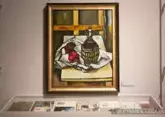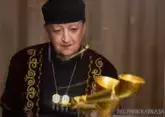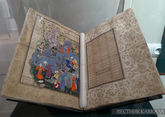The Moscow State Museum of Oriental Art has opened an exhibition titled 'Harmony of space. Traditional Art of Azerbaijan.' More than 100 decorative and applied art objects of the Land of Fire are exhibited at the museum on Nikitsky Boulevard. The exhibition tells about the interior of Azerbaijani houses in the 19th - early 20th centuries with an emphasis on carpets.

At the opening of the exhibition, the cultural and tourism attaché of the Azerbaijani Embassy in Russia, Nigar Akhundova, conveyed greetings from Azerbaijani ambassador to Russia Polad Bulbul oglu, who noted that he likes to visit the State Museum of Oriental Art, which is linked to Azerbaijan by many exhibits and knowledge of Azerbaijani history and culture. "The excellent director, my long-term friend is here. To my great regret, I had to leave due to an urgent and important matter. The exhibition will be held at a high level," the diplomat is confident. He congratulated director of the Azerbaijan Carpet Museum Shirin Melikov and director of the State Museum of Oriental Art Alexander Sedov, as well as staff of both museums, who worked "as a single mechanism" on the eve of the exhibition, on the implementation of an interesting and significant project." Polad Bulbul oglu expressed hope that "this wonderful tandem" will repeatedly please the public with the results of joint creative work.

The curator of the exhibition, director of the Azerbaijani Carpet Museum Shirin Melikova told Vestnik Kavkaza that the exhibition shows special comfort and beauty of traditional Azerbaijani interior.
The Azerbaijani Carpet Museum displays items related to the wedding ceremony - the bride's dress and dowry. The bride's dress and accessories should have red accents as a symbol of protection, a new life. Among the gifts, richly decorated with gold embroidery, the mustache protector is of special interest. Azerbaijani dandies wore at night to preserve their lush mustache's shape during sleep.
The Museum of Oriental Art has one of the most extensive collections of the Caucasian art. However, it has special relations with Azerbaijan. The museum's history has began in 1918 with the Azerbaijani 'Bahmanli' carpet of the 19th century, the curator of the exhibition from the Museum of Oriental Art, Maria Filatova, told Vestnik Kavkaza.

Among the Museum of Oriental Art's collection - jewelry, jugs, bowls, trays, decorated with delicate ornaments, as well as 'ambassadorial' tablecloths. They were not put on the table, they were used to wrap gifts for the distinguished guests.

Director general of the State Museum of Oriental Art Alexander Sedov told Vestnik Kavkaza: "It’s very beautiful and very colorful here. Many exhibits from the collection of the Baku Carpet Museum and from our collection, which are not displayed at our internal exhibitions often, are really unique. So, the exhibition composed of the two museums' collections is surprisingly completed."
One window displays tools and other attributes for making kelaghayi - silk headscarves, which still remain an integral part of an Azerbaijani woman's wardrobe. For centuries, handmade embroidery has played a large role in Azerbaijani interior and clothing. The clothing reflected not only local peculiarities of the country's historical and ethnographic zones, but also a person's status and marriage status.

Theater and film actress Valentina Titova, who visited the exhibition, told Vestnik Kavkaza: "Now, not many people are engaged in it, but everything that is hard to make is preserved for many years. Antiques draw people's attention, and that's how culture comes into our life."
The 'Harmony of space. Traditional Art of Azerbaijan' exhibition will run until May 12. It was organized by the Russian and Azerbaijani Culture Ministries, the Embassy of Azerbaijan, the State Museum of Oriental Art and the Azerbaijan Carpet Museum.



































